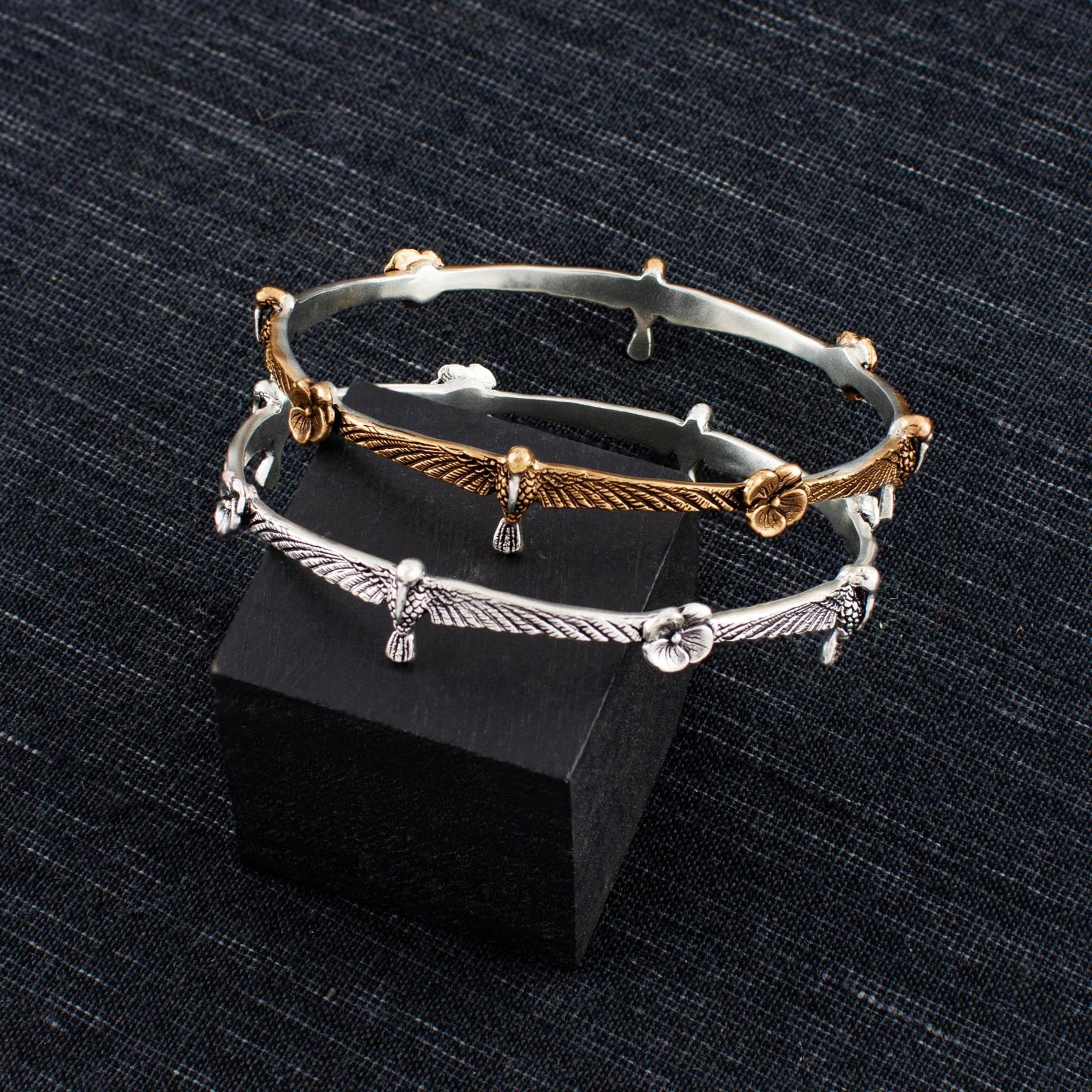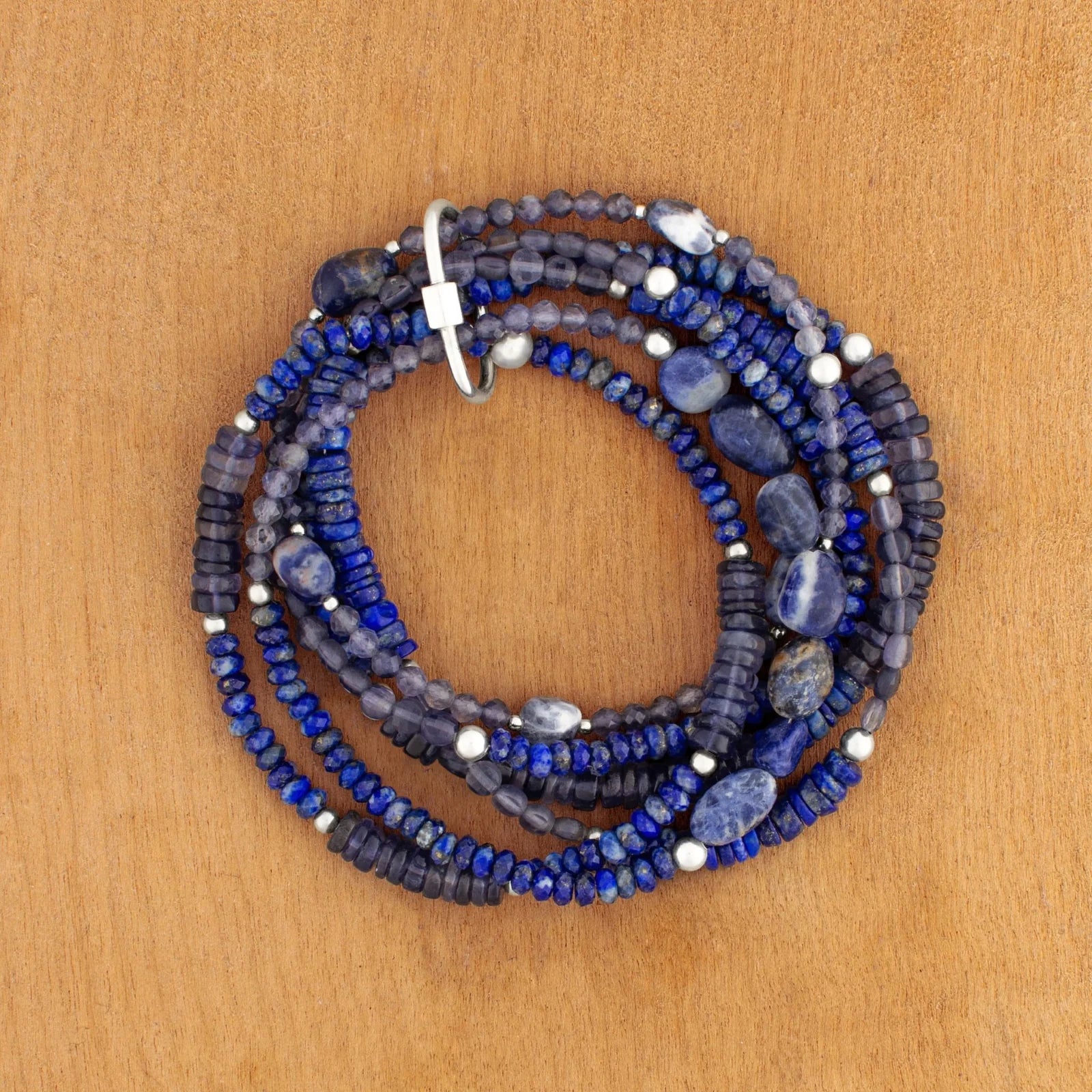Jewelry Care
CLEANING
STERLING SILVER
925 Sterling Silver is an alloy made up of 92.5% pure silver and 7.5% other metals, usually copper. It is a popular metal for jewelry because of its strength and shine. It is also hypoallergenic, making it a great choice for those with sensitive skin.
Sterling silver tarnishes because of a chemical reaction between the silver and sulfur or hydrogen sulfide in the air. This reaction causes a thin layer of silver sulfide to form on the surface of the silver, which is what gives it a tarnished appearance. This is an inherent characteristic of sterling silver and is not considered a defect.
Sterling silver jewelry is easy to care for and can be cleaned using a few methods.
- A purchased jewelry cleaning solution (we like the kind with the dipping basket.) Follow the instructions on the container.
- An at-home remedy like a mild soap and water solution, or a paste made of baking soda and water. Rub lightly with a cloth or soft bristle toothbrush, pat dry & buff with a cotton or microfiber cloth.
- You can also use a soft jewelry cloth to buff the jewelry and restore its shine. Jewelry cloths are impregnated with a polishing agent. After polishing gently with the jewelry cloth, lightly rub the jewelry with a cotton cloth to remove excess polishing material.
- Avoid using harsh chemicals or abrasive materials, as these can damage the jewelry.
24K GOLD PLATED STERLING SILVER
Our gold-plated jewelry is made with a base of sterling silver and a layer of gold that is at least 1 micron thick. The gold plating typically lasts anywhere from 6 months to 2 years, depending on how the jewelry is cared for and how often it is worn. To extend the life of your gold-plated jewelry, see below.
- Store gold plated jewelry in a cool, dry place away from direct sunlight.
- Avoid contact with harsh chemicals, such as chlorine, perfume, lotion, and hairspray.
- Clean gold-plated jewelry with a soft cloth or a jewelry cleaning solution specifically designed for gold plated jewelry.
- Avoid wearing gold-plated jewelry while swimming or bathing.
- Remove gold plated jewelry before engaging in any physical activity.
BRONZE
Bronze is an alloy made up of copper and tin. It is a strong and durable metal that has been used for centuries to make tools, weapons, and decorative objects. The color of bronze is determined by the proportions of copper and tin used in the alloy. The more copper used, the redder the bronze will be. The more tin used, the more yellow the bronze will be. Because all of our products are handmade, the color of our bronze jewelry can vary slightly.
Bronze tarnishes because it is a metal alloy that contains copper, which reacts with oxygen and moisture in the air to form a layer of copper oxide on the surface of the metal. This layer of copper oxide is what gives bronze its characteristic greenish-brown color.
Bronze can be cleaned using the following methods.
- You can use a soft cloth and a mild soap and water solution. Gently rub the bronze with the cloth and the soap and water solution to remove dirt and grime. Rinse the bronze with clean water and dry it with a soft cloth.
- To restore the color of lightly tarnished bronze, you can dip your jewelry in white vinegar. Rinse the bronze with clean water and dry it with a soft cloth.
- If the bronze is heavily tarnished, you can use a commercial bronze cleaner or a mixture of equal parts white vinegar and flour. Apply the cleaner or mixture to the bronze and let it sit for a few minutes before scrubbing.
SEMI-PREICOUS GEMSTONES
- Most (see exceptions below) semi-precious gemstones can be cleaned with a soft cloth and warm, soapy water.
- Avoid using harsh chemicals or abrasives, as these can damage the gemstone.
- Clean bezels, ring settings and drill holes, with a soft bristle toothbrush.
- After cleaning, rinse the gemstone with clean water and dry it with a soft cloth.
- Keep semi-precious gemstones away from direct sunlight and other sources of heat, as this can cause fading or discoloration.
- Avoid contact with harsh chemicals, such as chlorine, perfume, lotion, and hairspray.
GEMSTONE EXCEPTIONS
OPALS
Opals are fiery and temperamental (probably why love them). Ironically, this fiery stone naturally contains 3-5% water and maintaining the original water balance is critical to the longevity of the stone.
- Opals can be cleaned with a soft damp cloth (water).
- Pat dry with a soft cloth immediately.
- Avoid using harsh chemicals or abrasives, as these can damage and discolor the opal. clean bezels, ring settings and drill holes using a dry soft bristle toothbrush.
- Opals should not be exposed to heat or excessive sunlight. Exposure can cause the stone to dry out, turning the opal a dark, opaque brown.
- Opals are porous and absorb water, so they should not be submerged in water (no pools, hot tubs, saunas, or showers).
- Avoid contact with harsh chemicals, such as chlorine, perfume, lotion, cosmetics, and hairspray.
- Do not wear your opals when performing manual labor or participating in sports activities.
PEARLS
Caring for your pearls is all about maintaining the luster. Pearls can lose their luster when exposed to chemicals, dirt, oils, and other pollutants. These pollutants can erode the pearl's outer layer, making it look dull and lifeless.
- Store your pearls in a soft pouch or cloth.
- Avoid contact with chemicals and cosmetics.
- Clean your pearls with a soft, damp cloth after each use.
- Do not expose your pearls to extreme temperatures or humidity.
- Do not wear your pearls when performing manual labor or participating in sports activities.
- Bring your pearls to a professional jeweler for periodic cleaning and restringing.
ADJUSTING YOUR JEWELRY
CUFFS & RINGS
We design our cuffs and some of our rings to be adjustable, providing each wearer with the perfect fit.
- Each piece is meant to be adjusted once, not repeatedly opened and closed.
- Repeated adjustments can cause the metal to weaken and it can eventually break.
- To adjust your cuff or ring, gently cup the piece in both hands and apply steady and equal pressure to both sides.
- If you have concerns about sizing, contact us before your purchase
- We are happy to adjust your piece based on your specific requirements.
EARRING CLOSURES
We design our earrings to be both secure and easy to wear. Our jewelry is crafted using high-quality metals. All posts and ear wires are 925 sterling silver and 24k gold plate over sterling, both considered to be hypoallergenic for most people.
HOOPS
- Position the hoop in front of you with the clasp facing upward.
- Keeping the earring in the same position, gently unhook the clasp.
- Carefully push the thin wire end away from you—similar to how you’d open a paperclip.
- This will create a small gap between the ends of the circle, so the earring can now be inserted into the piercing.
- To close, guide the wire end into the closure behind your ear to secure.
- Following these steps allows the earring to open and close while maintaining its shape.
- Opening by pulling the closure and hoop apart from one another can cause damage to the hoop's structure.
CLICKERS
- To open, gently press the “post” down, taking care not to bend the ear wire.
- This will release the pressure from the back of the earring.
- To close, push back into place, taking note of the subtle "click" indicating the earring is fastened and secure.
- If your ear wire becomes bent & is not “clicking” into place, apply gentle upward pressure on the ear wire until it “clicks” back into place when closed.
- Pressure should be gentle & consistent to maintain the wire's shape and prevent damage.
HOOKS
- Slide the hook through your ear, situating the top of the curve at your earlobe.
THREADERS
- Slide the threader through your ear, situating the top of the curve at your earlobe
POSTS
- All of our post earrings come with butterfly backs in either sterling silver or 24k gold plated sterling.
- Carefully pull the butterfly back off the earring post, slide the post through your ear, and replace the back to secure.
- If you find your butterfly backs are too loose for the post, gently tighten them by pushing the two loops closer together.



